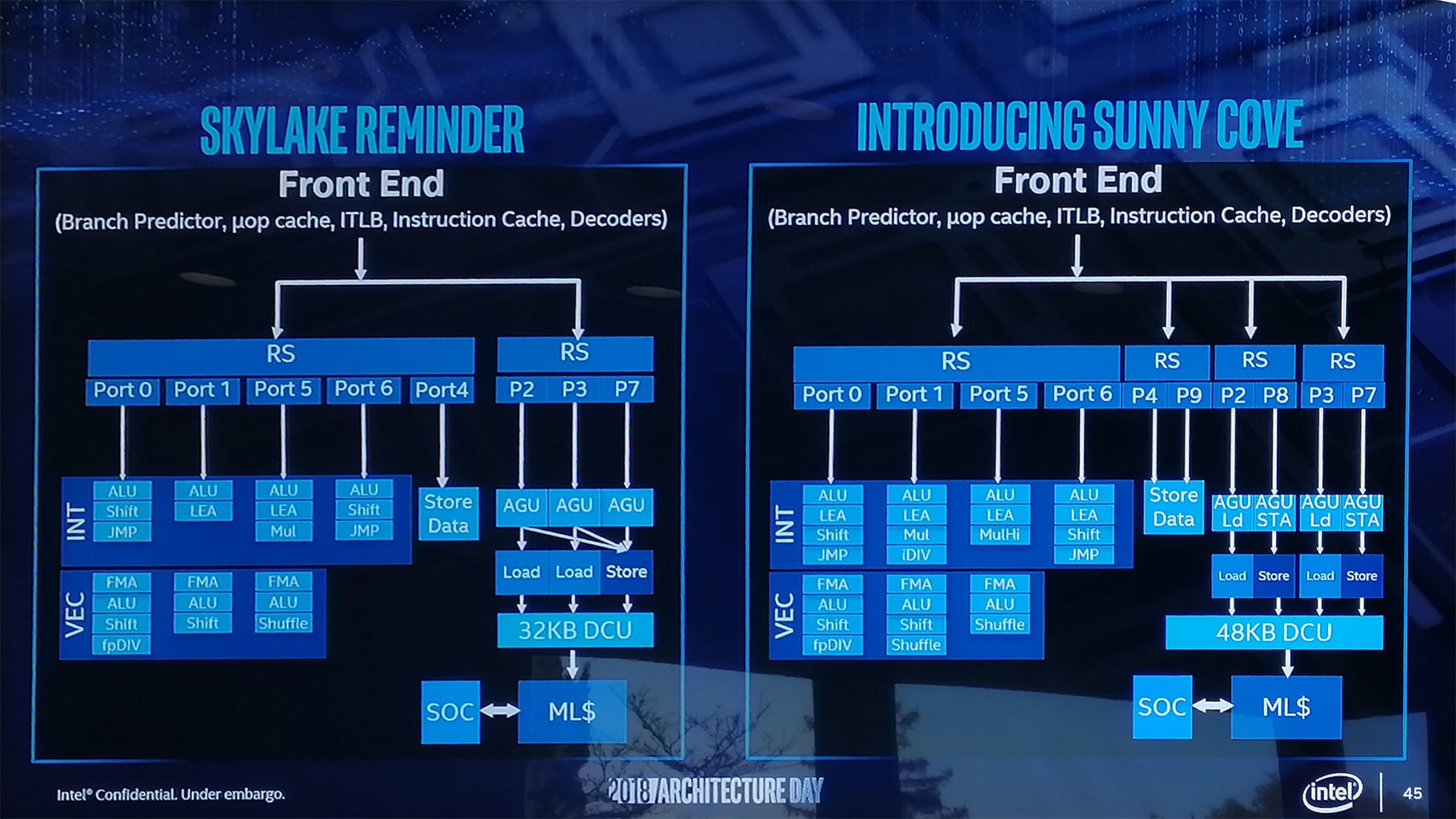- Joined
- Oct 9, 2007
- Messages
- 47,609 (7.45/day)
- Location
- Dublin, Ireland
| System Name | RBMK-1000 |
|---|---|
| Processor | AMD Ryzen 7 5700G |
| Motherboard | Gigabyte B550 AORUS Elite V2 |
| Cooling | DeepCool Gammax L240 V2 |
| Memory | 2x 16GB DDR4-3200 |
| Video Card(s) | Galax RTX 4070 Ti EX |
| Storage | Samsung 990 1TB |
| Display(s) | BenQ 1440p 60 Hz 27-inch |
| Case | Corsair Carbide 100R |
| Audio Device(s) | ASUS SupremeFX S1220A |
| Power Supply | Cooler Master MWE Gold 650W |
| Mouse | ASUS ROG Strix Impact |
| Keyboard | Gamdias Hermes E2 |
| Software | Windows 11 Pro |
Intel today unveiled its first clean-slate CPU core micro-architecture since "Nehalem," codenamed "Sunny Cove." Over the past decade, the 9-odd generations of Core processors were based on incrementally refined descendants of "Nehalem," running all the way down to "Coffee Lake." Intel now wants a clean-slate core design, much like AMD "Zen" is a clean-slate compared to "Stars" or to a large extent even "Bulldozer." This allows Intel to introduce significant gains in IPC (single-thread performance) over the current generation. Intel's IPC growth curve over the past three micro-architectures has remained flat, and only grew single-digit percentages over the generations prior.
It's important to note here, that "Sunny Cove" is the codename for the core design. Intel's earlier codenaming was all-encompassing, covering not just cores, but also uncore, and entire dies. It's up to Intel's future chip-designers to design dies with many of these cores, a future-generation iGPU such as Gen11, and a next-generation uncore that probably integrates PCIe gen 4.0 and DDR5 memory. Intel details "Sunny Cove" as far as mentioning IPC gains, a new ISA (new instruction sets and hardware capabilities, including AVX-512), and improved scalability (ability to increase core-counts without running into latency problems).
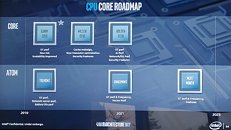
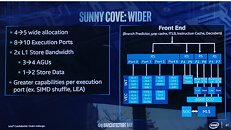
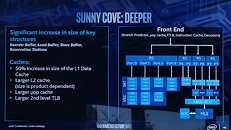
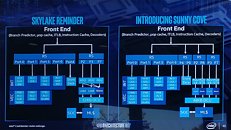
The first products featuring "Sunny Cove" cores is slated as early as by 2019, and will be built on Intel's 10 nm DUV silicon fabrication process. Intel didn't stop at "Sunny Cove," and went on to mention two of its successors. "Willow Cove" is an incremental update, letting its designers eke out more effective IPC by improving on-die caches, transistor optimization, and the addition of new security features. In many ways, "Sunnycove" and "Willow Cove" relate to each other like AMD's "Zen" and "Zen+." The first "Willow Cove" based processors will launch in 2020, based on a refined 10 nm process node.

Lastly there's "Golden Cove," slated for 2021. Here Intel could take advantage of a newer silicon fabrication process (either an extremely refined 10 nm-derivative or even 7 nm EUV), to increase IPC (single-thread performance). In addition, Intel will improve the core's "AI performance" (probably the ability to multiply matrices), and improved host-signal processing for 5G and networking.
Intel's low-power architectures see "Tremont" succeed "Goldmont" in 2019, packing increased IPC, battery management, and network HSP. "Gracemont," slated for 2021, will improve IPC further, and improve "Vector performance," possibly heralding AVX in some form to the low-power architecture. Gracemont is succeeded by "next" mont (Intel hasn't decided a codename yet) in 2022+, with even higher IPC.
View at TechPowerUp Main Site
It's important to note here, that "Sunny Cove" is the codename for the core design. Intel's earlier codenaming was all-encompassing, covering not just cores, but also uncore, and entire dies. It's up to Intel's future chip-designers to design dies with many of these cores, a future-generation iGPU such as Gen11, and a next-generation uncore that probably integrates PCIe gen 4.0 and DDR5 memory. Intel details "Sunny Cove" as far as mentioning IPC gains, a new ISA (new instruction sets and hardware capabilities, including AVX-512), and improved scalability (ability to increase core-counts without running into latency problems).




The first products featuring "Sunny Cove" cores is slated as early as by 2019, and will be built on Intel's 10 nm DUV silicon fabrication process. Intel didn't stop at "Sunny Cove," and went on to mention two of its successors. "Willow Cove" is an incremental update, letting its designers eke out more effective IPC by improving on-die caches, transistor optimization, and the addition of new security features. In many ways, "Sunnycove" and "Willow Cove" relate to each other like AMD's "Zen" and "Zen+." The first "Willow Cove" based processors will launch in 2020, based on a refined 10 nm process node.

Lastly there's "Golden Cove," slated for 2021. Here Intel could take advantage of a newer silicon fabrication process (either an extremely refined 10 nm-derivative or even 7 nm EUV), to increase IPC (single-thread performance). In addition, Intel will improve the core's "AI performance" (probably the ability to multiply matrices), and improved host-signal processing for 5G and networking.
Intel's low-power architectures see "Tremont" succeed "Goldmont" in 2019, packing increased IPC, battery management, and network HSP. "Gracemont," slated for 2021, will improve IPC further, and improve "Vector performance," possibly heralding AVX in some form to the low-power architecture. Gracemont is succeeded by "next" mont (Intel hasn't decided a codename yet) in 2022+, with even higher IPC.
View at TechPowerUp Main Site





